Diet and Nutrition for Health
VerifiedAdded on 2020/05/11
|10
|4051
|243
AI Summary
This assignment examines the crucial relationship between diet and nutrition in maintaining overall health and optimizing athletic performance. Students are tasked with analyzing the impact of specific dietary components like fiber, iron, calcium, and vitamin D on various health outcomes, including type 2 diabetes, cardiovascular disease, osteoporosis, and inflammation. The analysis involves evaluating research articles and synthesizing information to understand the complex interplay between diet, nutrition, and health.
Contribute Materials
Your contribution can guide someone’s learning journey. Share your
documents today.
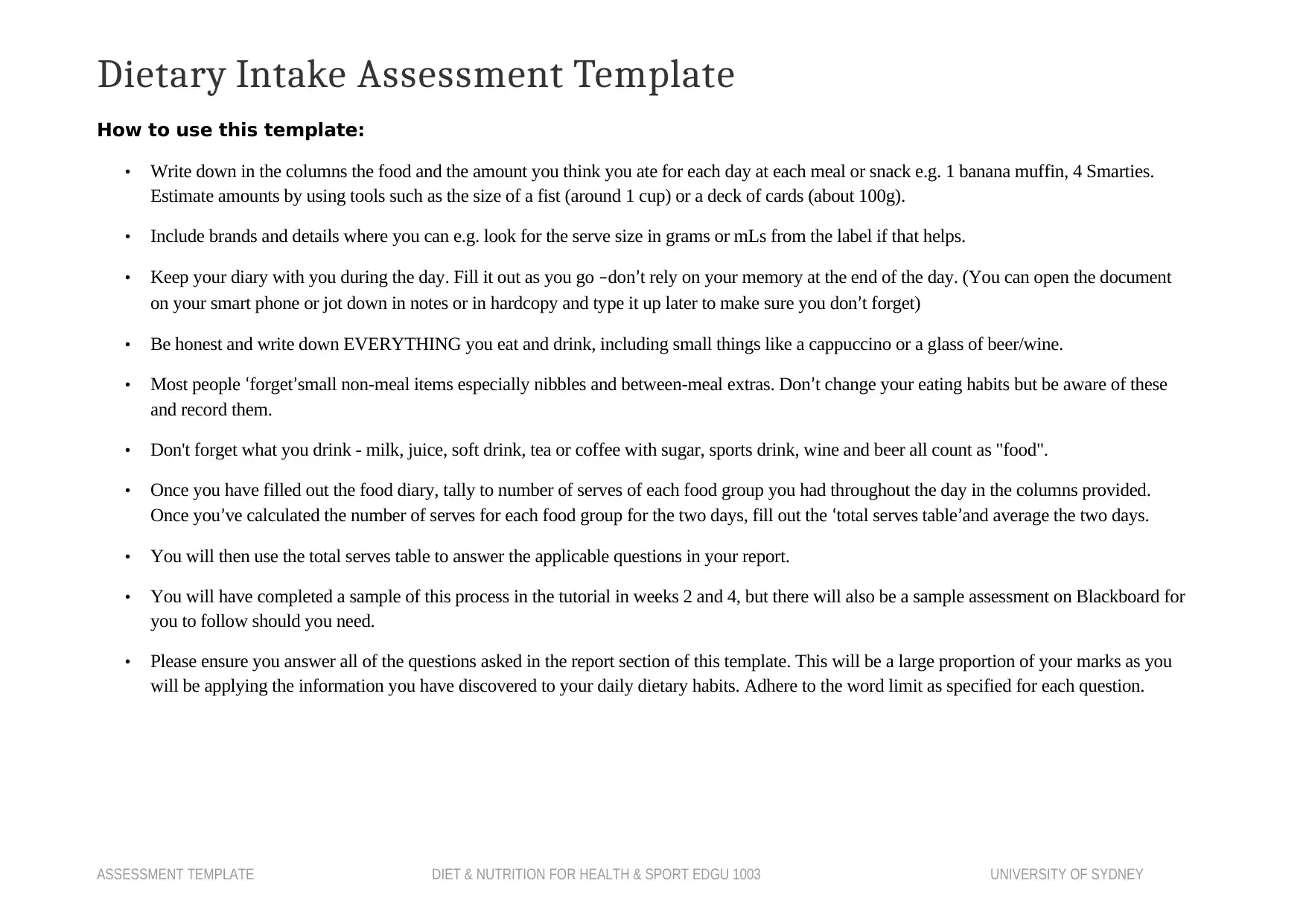
Dietary Intake Assessment Template
How to use this template:
• Write down in the columns the food and the amount you think you ate for each day at each meal or snack e.g. 1 banana muffin, 4 Smarties.
Estimate amounts by using tools such as the size of a fist (around 1 cup) or a deck of cards (about 100g).
• Include brands and details where you can e.g. look for the serve size in grams or mLs from the label if that helps.
• Keep your diary with you during the day. Fill it out as you go –don’t rely on your memory at the end of the day. (You can open the document
on your smart phone or jot down in notes or in hardcopy and type it up later to make sure you don’t forget)
• Be honest and write down EVERYTHING you eat and drink, including small things like a cappuccino or a glass of beer/wine.
• Most people ‘forget’small non-meal items especially nibbles and between-meal extras. Don’t change your eating habits but be aware of these
and record them.
• Don't forget what you drink - milk, juice, soft drink, tea or coffee with sugar, sports drink, wine and beer all count as "food".
• Once you have filled out the food diary, tally to number of serves of each food group you had throughout the day in the columns provided.
Once you’ve calculated the number of serves for each food group for the two days, fill out the ‘total serves table’and average the two days.
• You will then use the total serves table to answer the applicable questions in your report.
• You will have completed a sample of this process in the tutorial in weeks 2 and 4, but there will also be a sample assessment on Blackboard for
you to follow should you need.
• Please ensure you answer all of the questions asked in the report section of this template. This will be a large proportion of your marks as you
will be applying the information you have discovered to your daily dietary habits. Adhere to the word limit as specified for each question.
ASSESSMENT TEMPLATE DIET & NUTRITION FOR HEALTH & SPORT EDGU 1003 UNIVERSITY OF SYDNEY
How to use this template:
• Write down in the columns the food and the amount you think you ate for each day at each meal or snack e.g. 1 banana muffin, 4 Smarties.
Estimate amounts by using tools such as the size of a fist (around 1 cup) or a deck of cards (about 100g).
• Include brands and details where you can e.g. look for the serve size in grams or mLs from the label if that helps.
• Keep your diary with you during the day. Fill it out as you go –don’t rely on your memory at the end of the day. (You can open the document
on your smart phone or jot down in notes or in hardcopy and type it up later to make sure you don’t forget)
• Be honest and write down EVERYTHING you eat and drink, including small things like a cappuccino or a glass of beer/wine.
• Most people ‘forget’small non-meal items especially nibbles and between-meal extras. Don’t change your eating habits but be aware of these
and record them.
• Don't forget what you drink - milk, juice, soft drink, tea or coffee with sugar, sports drink, wine and beer all count as "food".
• Once you have filled out the food diary, tally to number of serves of each food group you had throughout the day in the columns provided.
Once you’ve calculated the number of serves for each food group for the two days, fill out the ‘total serves table’and average the two days.
• You will then use the total serves table to answer the applicable questions in your report.
• You will have completed a sample of this process in the tutorial in weeks 2 and 4, but there will also be a sample assessment on Blackboard for
you to follow should you need.
• Please ensure you answer all of the questions asked in the report section of this template. This will be a large proportion of your marks as you
will be applying the information you have discovered to your daily dietary habits. Adhere to the word limit as specified for each question.
ASSESSMENT TEMPLATE DIET & NUTRITION FOR HEALTH & SPORT EDGU 1003 UNIVERSITY OF SYDNEY
Secure Best Marks with AI Grader
Need help grading? Try our AI Grader for instant feedback on your assignments.
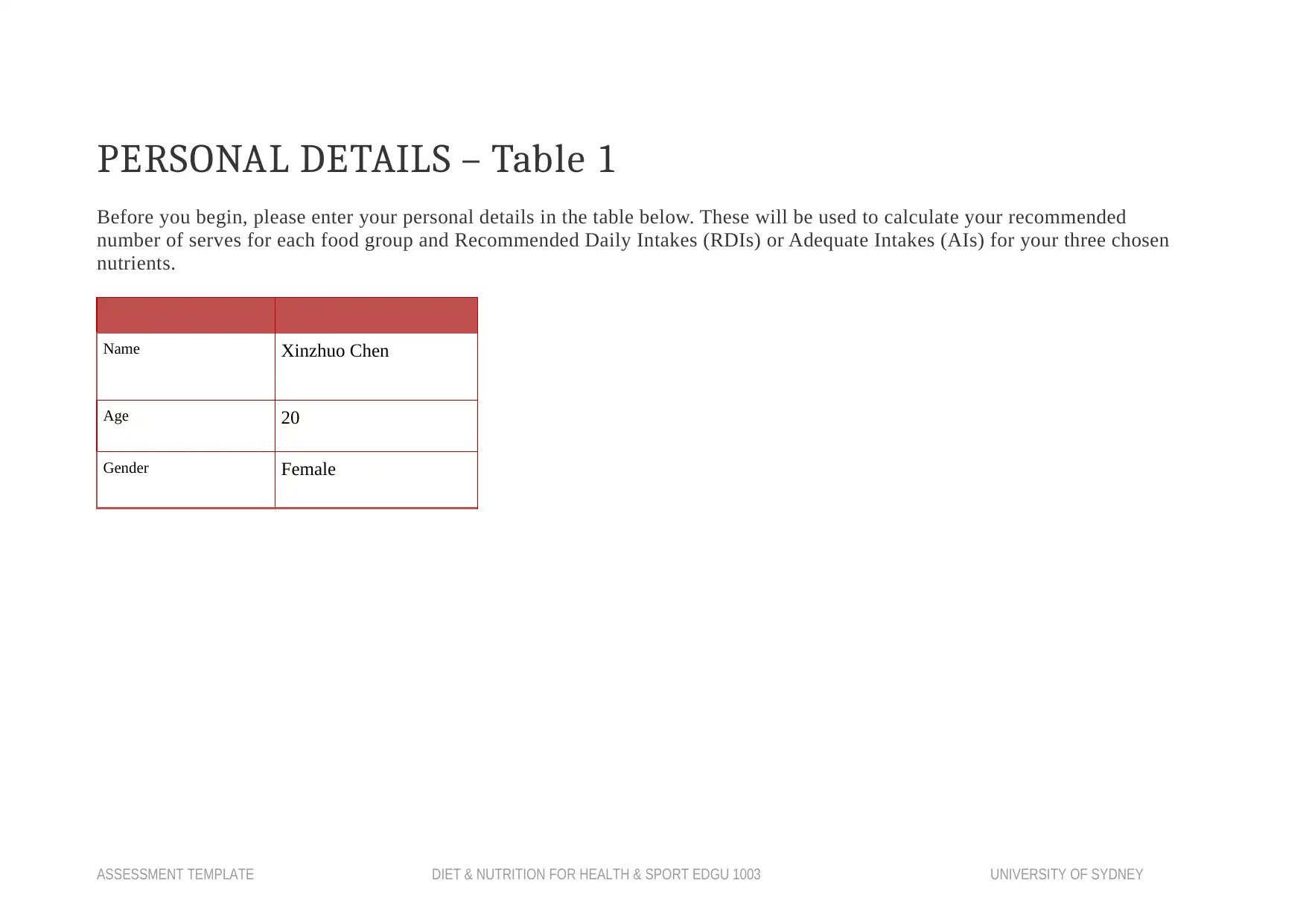
PERSONAL DETAILS – Table 1
Before you begin, please enter your personal details in the table below. These will be used to calculate your recommended
number of serves for each food group and Recommended Daily Intakes (RDIs) or Adequate Intakes (AIs) for your three chosen
nutrients.
Name Xinzhuo Chen
Age 20
Gender Female
ASSESSMENT TEMPLATE DIET & NUTRITION FOR HEALTH & SPORT EDGU 1003 UNIVERSITY OF SYDNEY
Before you begin, please enter your personal details in the table below. These will be used to calculate your recommended
number of serves for each food group and Recommended Daily Intakes (RDIs) or Adequate Intakes (AIs) for your three chosen
nutrients.
Name Xinzhuo Chen
Age 20
Gender Female
ASSESSMENT TEMPLATE DIET & NUTRITION FOR HEALTH & SPORT EDGU 1003 UNIVERSITY OF SYDNEY
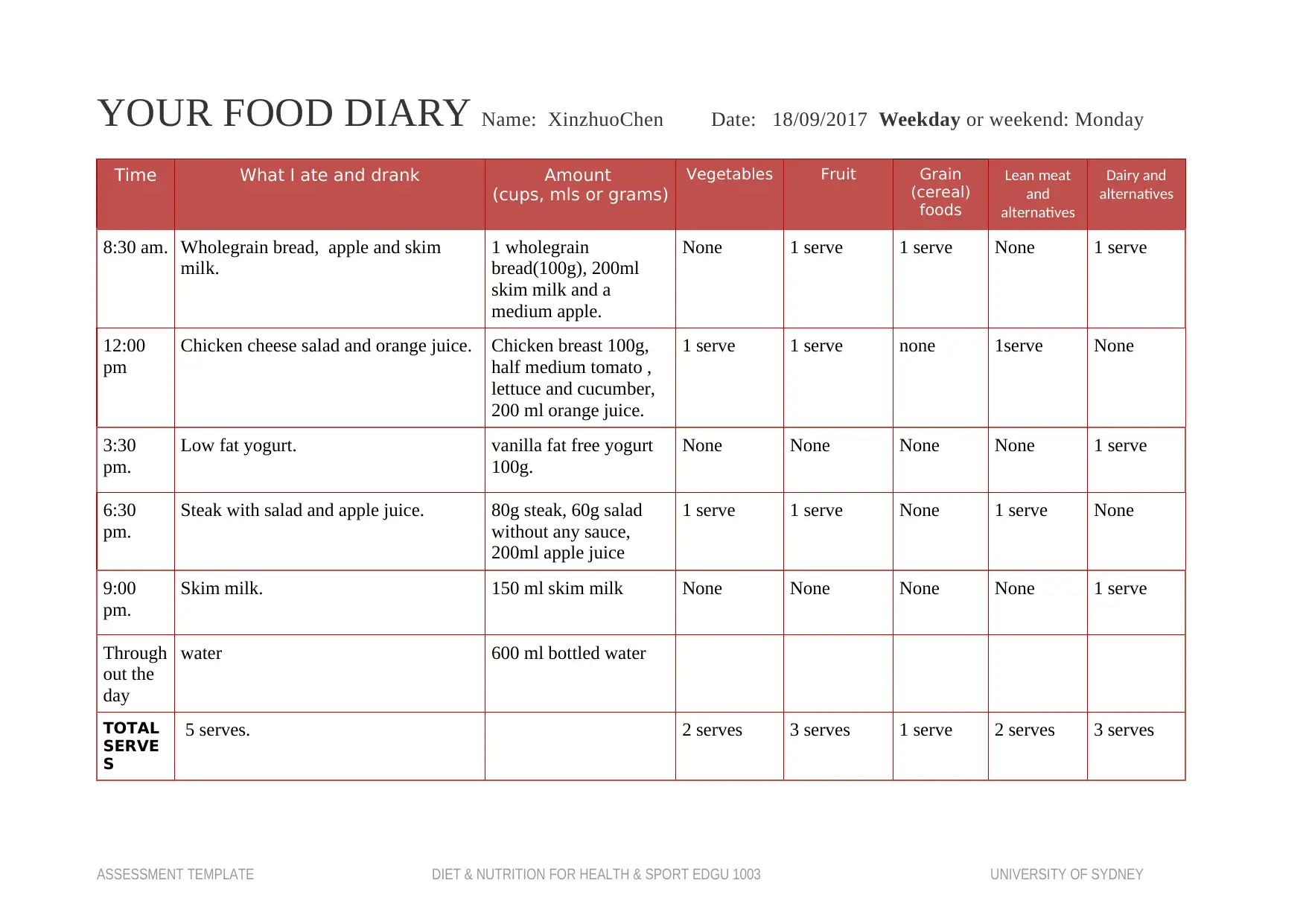
YOUR FOOD DIARY Name: XinzhuoChen Date: 18/09/2017 Weekday or weekend: Monday
Time What I ate and drank Amount
(cups, mls or grams)
Vegetables Fruit Grain
(cereal)
foods
Lean meat
and
alternatives
Dairy and
alternatives
8:30 am. Wholegrain bread, apple and skim
milk.
1 wholegrain
bread(100g), 200ml
skim milk and a
medium apple.
None 1 serve 1 serve None 1 serve
12:00
pm
Chicken cheese salad and orange juice. Chicken breast 100g,
half medium tomato ,
lettuce and cucumber,
200 ml orange juice.
1 serve 1 serve none 1serve None
3:30
pm.
Low fat yogurt. vanilla fat free yogurt
100g.
None None None None 1 serve
6:30
pm.
Steak with salad and apple juice. 80g steak, 60g salad
without any sauce,
200ml apple juice
1 serve 1 serve None 1 serve None
9:00
pm.
Skim milk. 150 ml skim milk None None None None 1 serve
Through
out the
day
water 600 ml bottled water
TOTAL
SERVE
S
5 serves. 2 serves 3 serves 1 serve 2 serves 3 serves
ASSESSMENT TEMPLATE DIET & NUTRITION FOR HEALTH & SPORT EDGU 1003 UNIVERSITY OF SYDNEY
Time What I ate and drank Amount
(cups, mls or grams)
Vegetables Fruit Grain
(cereal)
foods
Lean meat
and
alternatives
Dairy and
alternatives
8:30 am. Wholegrain bread, apple and skim
milk.
1 wholegrain
bread(100g), 200ml
skim milk and a
medium apple.
None 1 serve 1 serve None 1 serve
12:00
pm
Chicken cheese salad and orange juice. Chicken breast 100g,
half medium tomato ,
lettuce and cucumber,
200 ml orange juice.
1 serve 1 serve none 1serve None
3:30
pm.
Low fat yogurt. vanilla fat free yogurt
100g.
None None None None 1 serve
6:30
pm.
Steak with salad and apple juice. 80g steak, 60g salad
without any sauce,
200ml apple juice
1 serve 1 serve None 1 serve None
9:00
pm.
Skim milk. 150 ml skim milk None None None None 1 serve
Through
out the
day
water 600 ml bottled water
TOTAL
SERVE
S
5 serves. 2 serves 3 serves 1 serve 2 serves 3 serves
ASSESSMENT TEMPLATE DIET & NUTRITION FOR HEALTH & SPORT EDGU 1003 UNIVERSITY OF SYDNEY
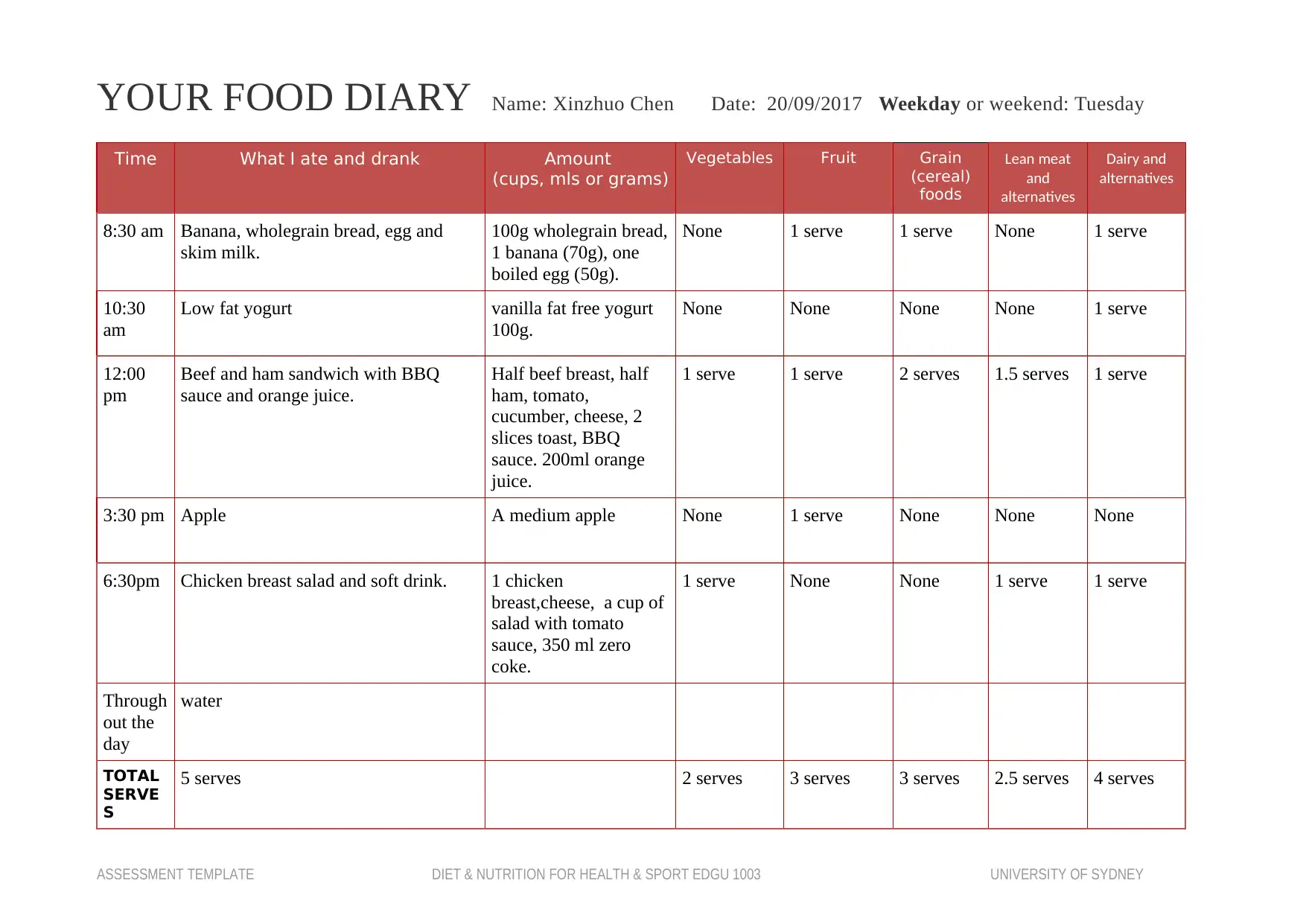
YOUR FOOD DIARY Name: Xinzhuo Chen Date: 20/09/2017 Weekday or weekend: Tuesday
Time What I ate and drank Amount
(cups, mls or grams)
Vegetables Fruit Grain
(cereal)
foods
Lean meat
and
alternatives
Dairy and
alternatives
8:30 am Banana, wholegrain bread, egg and
skim milk.
100g wholegrain bread,
1 banana (70g), one
boiled egg (50g).
None 1 serve 1 serve None 1 serve
10:30
am
Low fat yogurt vanilla fat free yogurt
100g.
None None None None 1 serve
12:00
pm
Beef and ham sandwich with BBQ
sauce and orange juice.
Half beef breast, half
ham, tomato,
cucumber, cheese, 2
slices toast, BBQ
sauce. 200ml orange
juice.
1 serve 1 serve 2 serves 1.5 serves 1 serve
3:30 pm Apple A medium apple None 1 serve None None None
6:30pm Chicken breast salad and soft drink. 1 chicken
breast,cheese, a cup of
salad with tomato
sauce, 350 ml zero
coke.
1 serve None None 1 serve 1 serve
Through
out the
day
water
TOTAL
SERVE
S
5 serves 2 serves 3 serves 3 serves 2.5 serves 4 serves
ASSESSMENT TEMPLATE DIET & NUTRITION FOR HEALTH & SPORT EDGU 1003 UNIVERSITY OF SYDNEY
Time What I ate and drank Amount
(cups, mls or grams)
Vegetables Fruit Grain
(cereal)
foods
Lean meat
and
alternatives
Dairy and
alternatives
8:30 am Banana, wholegrain bread, egg and
skim milk.
100g wholegrain bread,
1 banana (70g), one
boiled egg (50g).
None 1 serve 1 serve None 1 serve
10:30
am
Low fat yogurt vanilla fat free yogurt
100g.
None None None None 1 serve
12:00
pm
Beef and ham sandwich with BBQ
sauce and orange juice.
Half beef breast, half
ham, tomato,
cucumber, cheese, 2
slices toast, BBQ
sauce. 200ml orange
juice.
1 serve 1 serve 2 serves 1.5 serves 1 serve
3:30 pm Apple A medium apple None 1 serve None None None
6:30pm Chicken breast salad and soft drink. 1 chicken
breast,cheese, a cup of
salad with tomato
sauce, 350 ml zero
coke.
1 serve None None 1 serve 1 serve
Through
out the
day
water
TOTAL
SERVE
S
5 serves 2 serves 3 serves 3 serves 2.5 serves 4 serves
ASSESSMENT TEMPLATE DIET & NUTRITION FOR HEALTH & SPORT EDGU 1003 UNIVERSITY OF SYDNEY
Secure Best Marks with AI Grader
Need help grading? Try our AI Grader for instant feedback on your assignments.
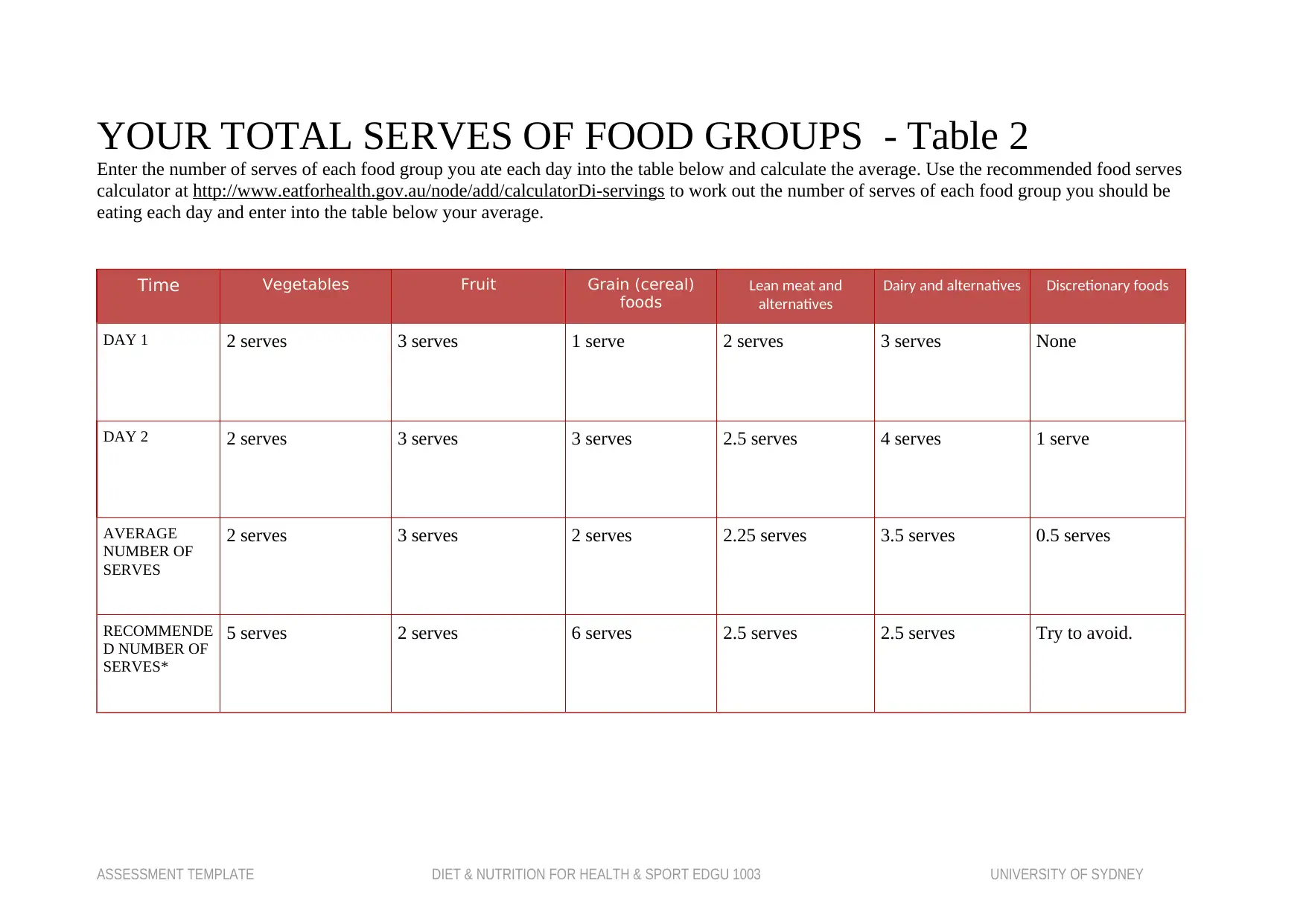
YOUR TOTAL SERVES OF FOOD GROUPS - Table 2
Enter the number of serves of each food group you ate each day into the table below and calculate the average. Use the recommended food serves
calculator at http://www.eatforhealth.gov.au/node/add/calculatorDi-servings to work out the number of serves of each food group you should be
eating each day and enter into the table below your average.
Time Vegetables Fruit Grain (cereal)
foods
Lean meat and
alternatives
Dairy and alternatives Discretionary foods
DAY 1 2 serves 3 serves 1 serve 2 serves 3 serves None
DAY 2 2 serves 3 serves 3 serves 2.5 serves 4 serves 1 serve
AVERAGE
NUMBER OF
SERVES
2 serves 3 serves 2 serves 2.25 serves 3.5 serves 0.5 serves
RECOMMENDE
D NUMBER OF
SERVES*
5 serves 2 serves 6 serves 2.5 serves 2.5 serves Try to avoid.
ASSESSMENT TEMPLATE DIET & NUTRITION FOR HEALTH & SPORT EDGU 1003 UNIVERSITY OF SYDNEY
Enter the number of serves of each food group you ate each day into the table below and calculate the average. Use the recommended food serves
calculator at http://www.eatforhealth.gov.au/node/add/calculatorDi-servings to work out the number of serves of each food group you should be
eating each day and enter into the table below your average.
Time Vegetables Fruit Grain (cereal)
foods
Lean meat and
alternatives
Dairy and alternatives Discretionary foods
DAY 1 2 serves 3 serves 1 serve 2 serves 3 serves None
DAY 2 2 serves 3 serves 3 serves 2.5 serves 4 serves 1 serve
AVERAGE
NUMBER OF
SERVES
2 serves 3 serves 2 serves 2.25 serves 3.5 serves 0.5 serves
RECOMMENDE
D NUMBER OF
SERVES*
5 serves 2 serves 6 serves 2.5 serves 2.5 serves Try to avoid.
ASSESSMENT TEMPLATE DIET & NUTRITION FOR HEALTH & SPORT EDGU 1003 UNIVERSITY OF SYDNEY
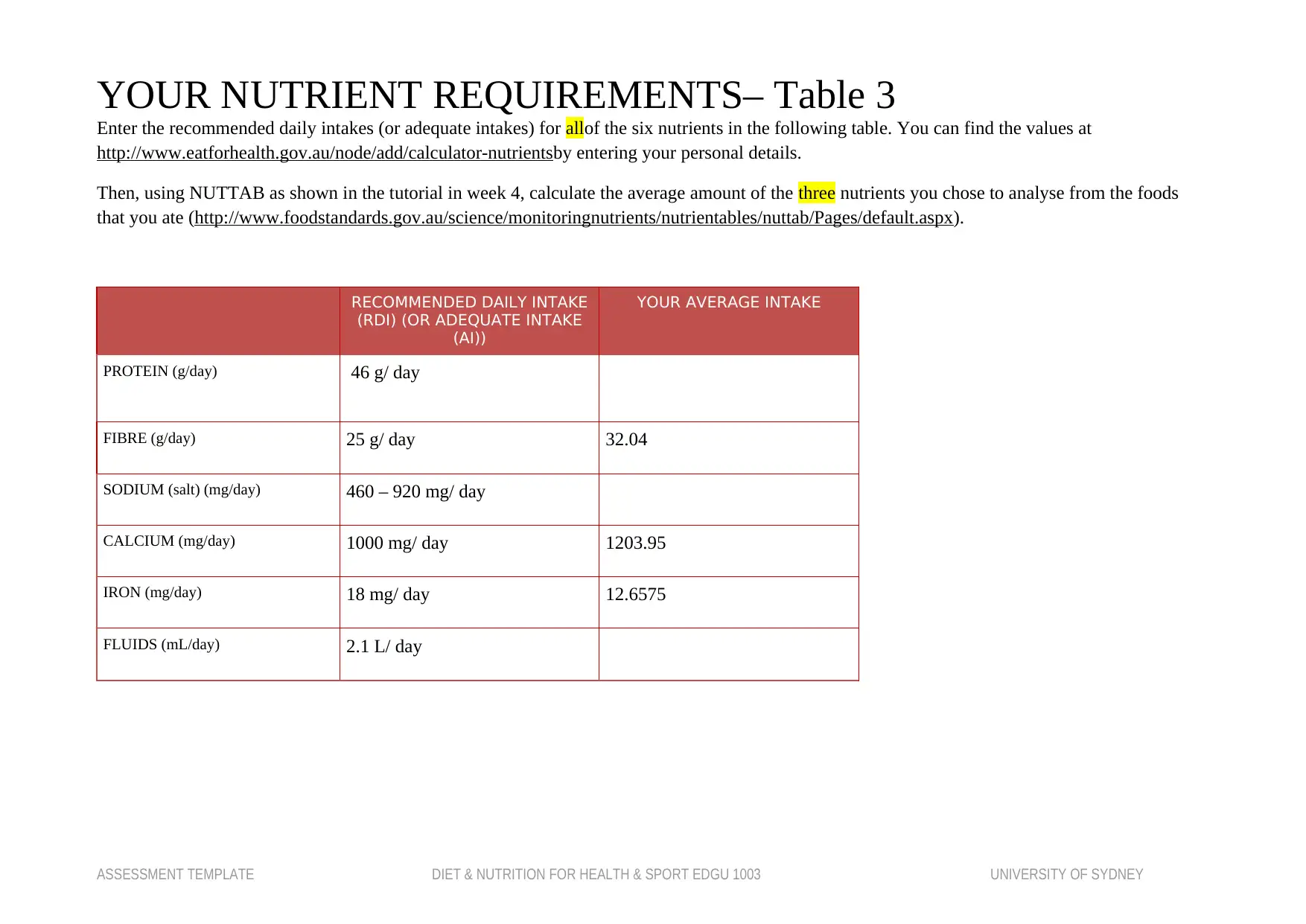
YOUR NUTRIENT REQUIREMENTS– Table 3
Enter the recommended daily intakes (or adequate intakes) for allof the six nutrients in the following table. You can find the values at
http://www.eatforhealth.gov.au/node/add/calculator-nutrientsby entering your personal details.
Then, using NUTTAB as shown in the tutorial in week 4, calculate the average amount of the three nutrients you chose to analyse from the foods
that you ate (http://www.foodstandards.gov.au/science/monitoringnutrients/nutrientables/nuttab/Pages/default.aspx).
RECOMMENDED DAILY INTAKE
(RDI) (OR ADEQUATE INTAKE
(AI))
YOUR AVERAGE INTAKE
PROTEIN (g/day) 46 g/ day
FIBRE (g/day) 25 g/ day 32.04
SODIUM (salt) (mg/day) 460 – 920 mg/ day
CALCIUM (mg/day) 1000 mg/ day 1203.95
IRON (mg/day) 18 mg/ day 12.6575
FLUIDS (mL/day) 2.1 L/ day
ASSESSMENT TEMPLATE DIET & NUTRITION FOR HEALTH & SPORT EDGU 1003 UNIVERSITY OF SYDNEY
Enter the recommended daily intakes (or adequate intakes) for allof the six nutrients in the following table. You can find the values at
http://www.eatforhealth.gov.au/node/add/calculator-nutrientsby entering your personal details.
Then, using NUTTAB as shown in the tutorial in week 4, calculate the average amount of the three nutrients you chose to analyse from the foods
that you ate (http://www.foodstandards.gov.au/science/monitoringnutrients/nutrientables/nuttab/Pages/default.aspx).
RECOMMENDED DAILY INTAKE
(RDI) (OR ADEQUATE INTAKE
(AI))
YOUR AVERAGE INTAKE
PROTEIN (g/day) 46 g/ day
FIBRE (g/day) 25 g/ day 32.04
SODIUM (salt) (mg/day) 460 – 920 mg/ day
CALCIUM (mg/day) 1000 mg/ day 1203.95
IRON (mg/day) 18 mg/ day 12.6575
FLUIDS (mL/day) 2.1 L/ day
ASSESSMENT TEMPLATE DIET & NUTRITION FOR HEALTH & SPORT EDGU 1003 UNIVERSITY OF SYDNEY
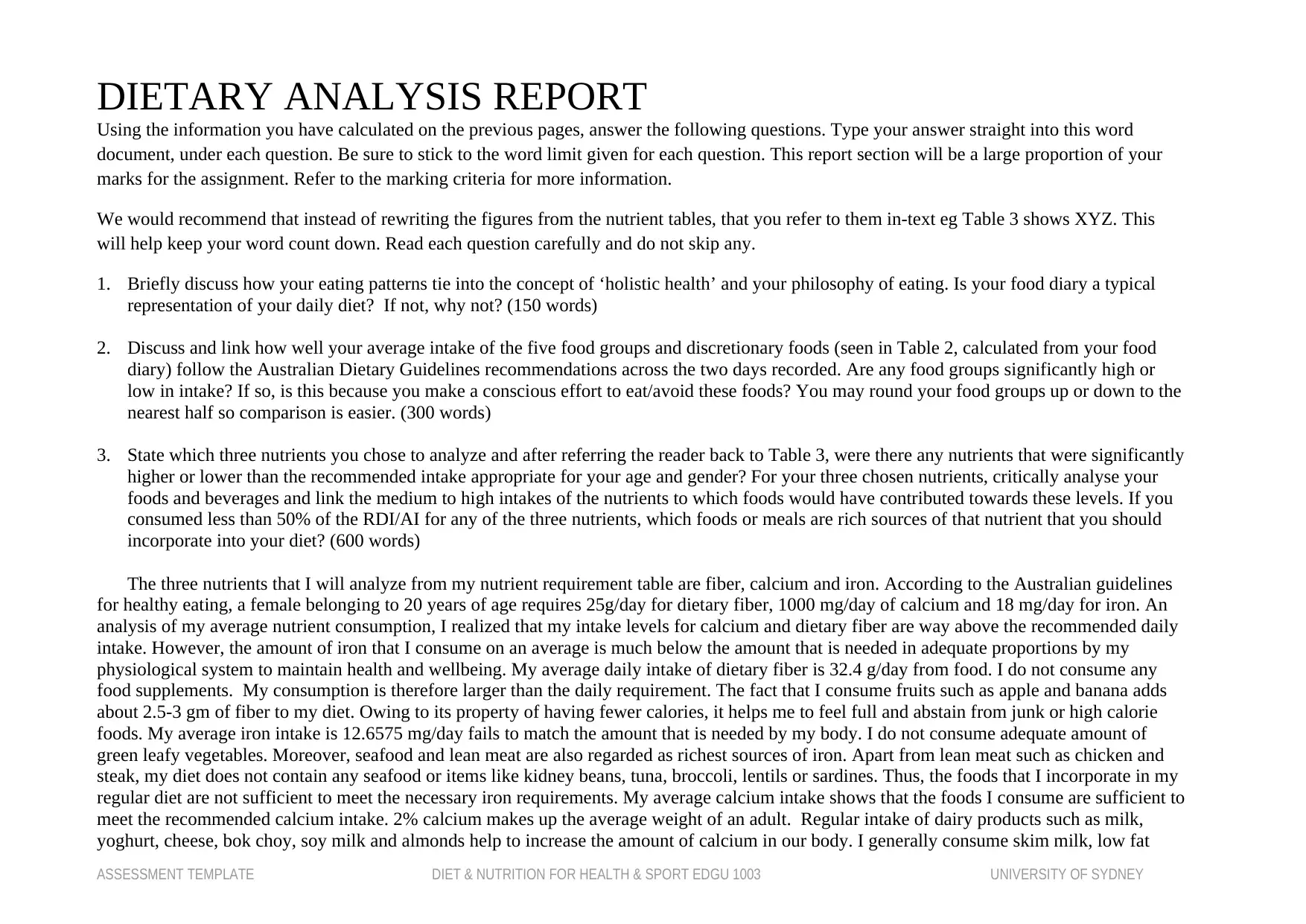
DIETARY ANALYSIS REPORT
Using the information you have calculated on the previous pages, answer the following questions. Type your answer straight into this word
document, under each question. Be sure to stick to the word limit given for each question. This report section will be a large proportion of your
marks for the assignment. Refer to the marking criteria for more information.
We would recommend that instead of rewriting the figures from the nutrient tables, that you refer to them in-text eg Table 3 shows XYZ. This
will help keep your word count down. Read each question carefully and do not skip any.
1. Briefly discuss how your eating patterns tie into the concept of ‘holistic health’ and your philosophy of eating. Is your food diary a typical
representation of your daily diet? If not, why not? (150 words)
2. Discuss and link how well your average intake of the five food groups and discretionary foods (seen in Table 2, calculated from your food
diary) follow the Australian Dietary Guidelines recommendations across the two days recorded. Are any food groups significantly high or
low in intake? If so, is this because you make a conscious effort to eat/avoid these foods? You may round your food groups up or down to the
nearest half so comparison is easier. (300 words)
3. State which three nutrients you chose to analyze and after referring the reader back to Table 3, were there any nutrients that were significantly
higher or lower than the recommended intake appropriate for your age and gender? For your three chosen nutrients, critically analyse your
foods and beverages and link the medium to high intakes of the nutrients to which foods would have contributed towards these levels. If you
consumed less than 50% of the RDI/AI for any of the three nutrients, which foods or meals are rich sources of that nutrient that you should
incorporate into your diet? (600 words)
The three nutrients that I will analyze from my nutrient requirement table are fiber, calcium and iron. According to the Australian guidelines
for healthy eating, a female belonging to 20 years of age requires 25g/day for dietary fiber, 1000 mg/day of calcium and 18 mg/day for iron. An
analysis of my average nutrient consumption, I realized that my intake levels for calcium and dietary fiber are way above the recommended daily
intake. However, the amount of iron that I consume on an average is much below the amount that is needed in adequate proportions by my
physiological system to maintain health and wellbeing. My average daily intake of dietary fiber is 32.4 g/day from food. I do not consume any
food supplements. My consumption is therefore larger than the daily requirement. The fact that I consume fruits such as apple and banana adds
about 2.5-3 gm of fiber to my diet. Owing to its property of having fewer calories, it helps me to feel full and abstain from junk or high calorie
foods. My average iron intake is 12.6575 mg/day fails to match the amount that is needed by my body. I do not consume adequate amount of
green leafy vegetables. Moreover, seafood and lean meat are also regarded as richest sources of iron. Apart from lean meat such as chicken and
steak, my diet does not contain any seafood or items like kidney beans, tuna, broccoli, lentils or sardines. Thus, the foods that I incorporate in my
regular diet are not sufficient to meet the necessary iron requirements. My average calcium intake shows that the foods I consume are sufficient to
meet the recommended calcium intake. 2% calcium makes up the average weight of an adult. Regular intake of dairy products such as milk,
yoghurt, cheese, bok choy, soy milk and almonds help to increase the amount of calcium in our body. I generally consume skim milk, low fat
ASSESSMENT TEMPLATE DIET & NUTRITION FOR HEALTH & SPORT EDGU 1003 UNIVERSITY OF SYDNEY
Using the information you have calculated on the previous pages, answer the following questions. Type your answer straight into this word
document, under each question. Be sure to stick to the word limit given for each question. This report section will be a large proportion of your
marks for the assignment. Refer to the marking criteria for more information.
We would recommend that instead of rewriting the figures from the nutrient tables, that you refer to them in-text eg Table 3 shows XYZ. This
will help keep your word count down. Read each question carefully and do not skip any.
1. Briefly discuss how your eating patterns tie into the concept of ‘holistic health’ and your philosophy of eating. Is your food diary a typical
representation of your daily diet? If not, why not? (150 words)
2. Discuss and link how well your average intake of the five food groups and discretionary foods (seen in Table 2, calculated from your food
diary) follow the Australian Dietary Guidelines recommendations across the two days recorded. Are any food groups significantly high or
low in intake? If so, is this because you make a conscious effort to eat/avoid these foods? You may round your food groups up or down to the
nearest half so comparison is easier. (300 words)
3. State which three nutrients you chose to analyze and after referring the reader back to Table 3, were there any nutrients that were significantly
higher or lower than the recommended intake appropriate for your age and gender? For your three chosen nutrients, critically analyse your
foods and beverages and link the medium to high intakes of the nutrients to which foods would have contributed towards these levels. If you
consumed less than 50% of the RDI/AI for any of the three nutrients, which foods or meals are rich sources of that nutrient that you should
incorporate into your diet? (600 words)
The three nutrients that I will analyze from my nutrient requirement table are fiber, calcium and iron. According to the Australian guidelines
for healthy eating, a female belonging to 20 years of age requires 25g/day for dietary fiber, 1000 mg/day of calcium and 18 mg/day for iron. An
analysis of my average nutrient consumption, I realized that my intake levels for calcium and dietary fiber are way above the recommended daily
intake. However, the amount of iron that I consume on an average is much below the amount that is needed in adequate proportions by my
physiological system to maintain health and wellbeing. My average daily intake of dietary fiber is 32.4 g/day from food. I do not consume any
food supplements. My consumption is therefore larger than the daily requirement. The fact that I consume fruits such as apple and banana adds
about 2.5-3 gm of fiber to my diet. Owing to its property of having fewer calories, it helps me to feel full and abstain from junk or high calorie
foods. My average iron intake is 12.6575 mg/day fails to match the amount that is needed by my body. I do not consume adequate amount of
green leafy vegetables. Moreover, seafood and lean meat are also regarded as richest sources of iron. Apart from lean meat such as chicken and
steak, my diet does not contain any seafood or items like kidney beans, tuna, broccoli, lentils or sardines. Thus, the foods that I incorporate in my
regular diet are not sufficient to meet the necessary iron requirements. My average calcium intake shows that the foods I consume are sufficient to
meet the recommended calcium intake. 2% calcium makes up the average weight of an adult. Regular intake of dairy products such as milk,
yoghurt, cheese, bok choy, soy milk and almonds help to increase the amount of calcium in our body. I generally consume skim milk, low fat
ASSESSMENT TEMPLATE DIET & NUTRITION FOR HEALTH & SPORT EDGU 1003 UNIVERSITY OF SYDNEY
Paraphrase This Document
Need a fresh take? Get an instant paraphrase of this document with our AI Paraphraser
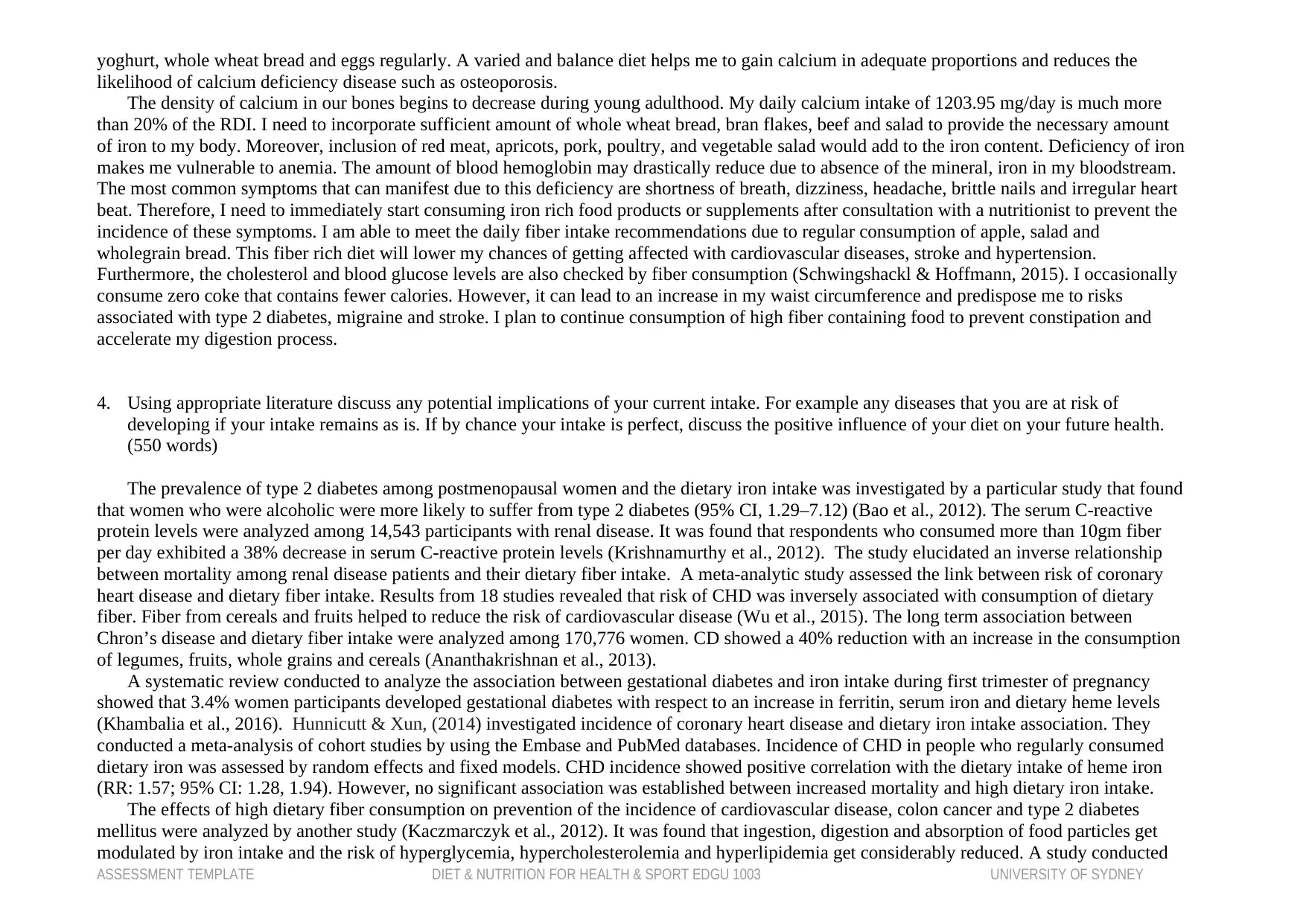
yoghurt, whole wheat bread and eggs regularly. A varied and balance diet helps me to gain calcium in adequate proportions and reduces the
likelihood of calcium deficiency disease such as osteoporosis.
The density of calcium in our bones begins to decrease during young adulthood. My daily calcium intake of 1203.95 mg/day is much more
than 20% of the RDI. I need to incorporate sufficient amount of whole wheat bread, bran flakes, beef and salad to provide the necessary amount
of iron to my body. Moreover, inclusion of red meat, apricots, pork, poultry, and vegetable salad would add to the iron content. Deficiency of iron
makes me vulnerable to anemia. The amount of blood hemoglobin may drastically reduce due to absence of the mineral, iron in my bloodstream.
The most common symptoms that can manifest due to this deficiency are shortness of breath, dizziness, headache, brittle nails and irregular heart
beat. Therefore, I need to immediately start consuming iron rich food products or supplements after consultation with a nutritionist to prevent the
incidence of these symptoms. I am able to meet the daily fiber intake recommendations due to regular consumption of apple, salad and
wholegrain bread. This fiber rich diet will lower my chances of getting affected with cardiovascular diseases, stroke and hypertension.
Furthermore, the cholesterol and blood glucose levels are also checked by fiber consumption (Schwingshackl & Hoffmann, 2015). I occasionally
consume zero coke that contains fewer calories. However, it can lead to an increase in my waist circumference and predispose me to risks
associated with type 2 diabetes, migraine and stroke. I plan to continue consumption of high fiber containing food to prevent constipation and
accelerate my digestion process.
4. Using appropriate literature discuss any potential implications of your current intake. For example any diseases that you are at risk of
developing if your intake remains as is. If by chance your intake is perfect, discuss the positive influence of your diet on your future health.
(550 words)
The prevalence of type 2 diabetes among postmenopausal women and the dietary iron intake was investigated by a particular study that found
that women who were alcoholic were more likely to suffer from type 2 diabetes (95% CI, 1.29–7.12) (Bao et al., 2012). The serum C-reactive
protein levels were analyzed among 14,543 participants with renal disease. It was found that respondents who consumed more than 10gm fiber
per day exhibited a 38% decrease in serum C-reactive protein levels (Krishnamurthy et al., 2012). The study elucidated an inverse relationship
between mortality among renal disease patients and their dietary fiber intake. A meta-analytic study assessed the link between risk of coronary
heart disease and dietary fiber intake. Results from 18 studies revealed that risk of CHD was inversely associated with consumption of dietary
fiber. Fiber from cereals and fruits helped to reduce the risk of cardiovascular disease (Wu et al., 2015). The long term association between
Chron’s disease and dietary fiber intake were analyzed among 170,776 women. CD showed a 40% reduction with an increase in the consumption
of legumes, fruits, whole grains and cereals (Ananthakrishnan et al., 2013).
A systematic review conducted to analyze the association between gestational diabetes and iron intake during first trimester of pregnancy
showed that 3.4% women participants developed gestational diabetes with respect to an increase in ferritin, serum iron and dietary heme levels
(Khambalia et al., 2016). Hunnicutt & Xun, (2014) investigated incidence of coronary heart disease and dietary iron intake association. They
conducted a meta-analysis of cohort studies by using the Embase and PubMed databases. Incidence of CHD in people who regularly consumed
dietary iron was assessed by random effects and fixed models. CHD incidence showed positive correlation with the dietary intake of heme iron
(RR: 1.57; 95% CI: 1.28, 1.94). However, no significant association was established between increased mortality and high dietary iron intake.
The effects of high dietary fiber consumption on prevention of the incidence of cardiovascular disease, colon cancer and type 2 diabetes
mellitus were analyzed by another study (Kaczmarczyk et al., 2012). It was found that ingestion, digestion and absorption of food particles get
modulated by iron intake and the risk of hyperglycemia, hypercholesterolemia and hyperlipidemia get considerably reduced. A study conducted
ASSESSMENT TEMPLATE DIET & NUTRITION FOR HEALTH & SPORT EDGU 1003 UNIVERSITY OF SYDNEY
likelihood of calcium deficiency disease such as osteoporosis.
The density of calcium in our bones begins to decrease during young adulthood. My daily calcium intake of 1203.95 mg/day is much more
than 20% of the RDI. I need to incorporate sufficient amount of whole wheat bread, bran flakes, beef and salad to provide the necessary amount
of iron to my body. Moreover, inclusion of red meat, apricots, pork, poultry, and vegetable salad would add to the iron content. Deficiency of iron
makes me vulnerable to anemia. The amount of blood hemoglobin may drastically reduce due to absence of the mineral, iron in my bloodstream.
The most common symptoms that can manifest due to this deficiency are shortness of breath, dizziness, headache, brittle nails and irregular heart
beat. Therefore, I need to immediately start consuming iron rich food products or supplements after consultation with a nutritionist to prevent the
incidence of these symptoms. I am able to meet the daily fiber intake recommendations due to regular consumption of apple, salad and
wholegrain bread. This fiber rich diet will lower my chances of getting affected with cardiovascular diseases, stroke and hypertension.
Furthermore, the cholesterol and blood glucose levels are also checked by fiber consumption (Schwingshackl & Hoffmann, 2015). I occasionally
consume zero coke that contains fewer calories. However, it can lead to an increase in my waist circumference and predispose me to risks
associated with type 2 diabetes, migraine and stroke. I plan to continue consumption of high fiber containing food to prevent constipation and
accelerate my digestion process.
4. Using appropriate literature discuss any potential implications of your current intake. For example any diseases that you are at risk of
developing if your intake remains as is. If by chance your intake is perfect, discuss the positive influence of your diet on your future health.
(550 words)
The prevalence of type 2 diabetes among postmenopausal women and the dietary iron intake was investigated by a particular study that found
that women who were alcoholic were more likely to suffer from type 2 diabetes (95% CI, 1.29–7.12) (Bao et al., 2012). The serum C-reactive
protein levels were analyzed among 14,543 participants with renal disease. It was found that respondents who consumed more than 10gm fiber
per day exhibited a 38% decrease in serum C-reactive protein levels (Krishnamurthy et al., 2012). The study elucidated an inverse relationship
between mortality among renal disease patients and their dietary fiber intake. A meta-analytic study assessed the link between risk of coronary
heart disease and dietary fiber intake. Results from 18 studies revealed that risk of CHD was inversely associated with consumption of dietary
fiber. Fiber from cereals and fruits helped to reduce the risk of cardiovascular disease (Wu et al., 2015). The long term association between
Chron’s disease and dietary fiber intake were analyzed among 170,776 women. CD showed a 40% reduction with an increase in the consumption
of legumes, fruits, whole grains and cereals (Ananthakrishnan et al., 2013).
A systematic review conducted to analyze the association between gestational diabetes and iron intake during first trimester of pregnancy
showed that 3.4% women participants developed gestational diabetes with respect to an increase in ferritin, serum iron and dietary heme levels
(Khambalia et al., 2016). Hunnicutt & Xun, (2014) investigated incidence of coronary heart disease and dietary iron intake association. They
conducted a meta-analysis of cohort studies by using the Embase and PubMed databases. Incidence of CHD in people who regularly consumed
dietary iron was assessed by random effects and fixed models. CHD incidence showed positive correlation with the dietary intake of heme iron
(RR: 1.57; 95% CI: 1.28, 1.94). However, no significant association was established between increased mortality and high dietary iron intake.
The effects of high dietary fiber consumption on prevention of the incidence of cardiovascular disease, colon cancer and type 2 diabetes
mellitus were analyzed by another study (Kaczmarczyk et al., 2012). It was found that ingestion, digestion and absorption of food particles get
modulated by iron intake and the risk of hyperglycemia, hypercholesterolemia and hyperlipidemia get considerably reduced. A study conducted
ASSESSMENT TEMPLATE DIET & NUTRITION FOR HEALTH & SPORT EDGU 1003 UNIVERSITY OF SYDNEY
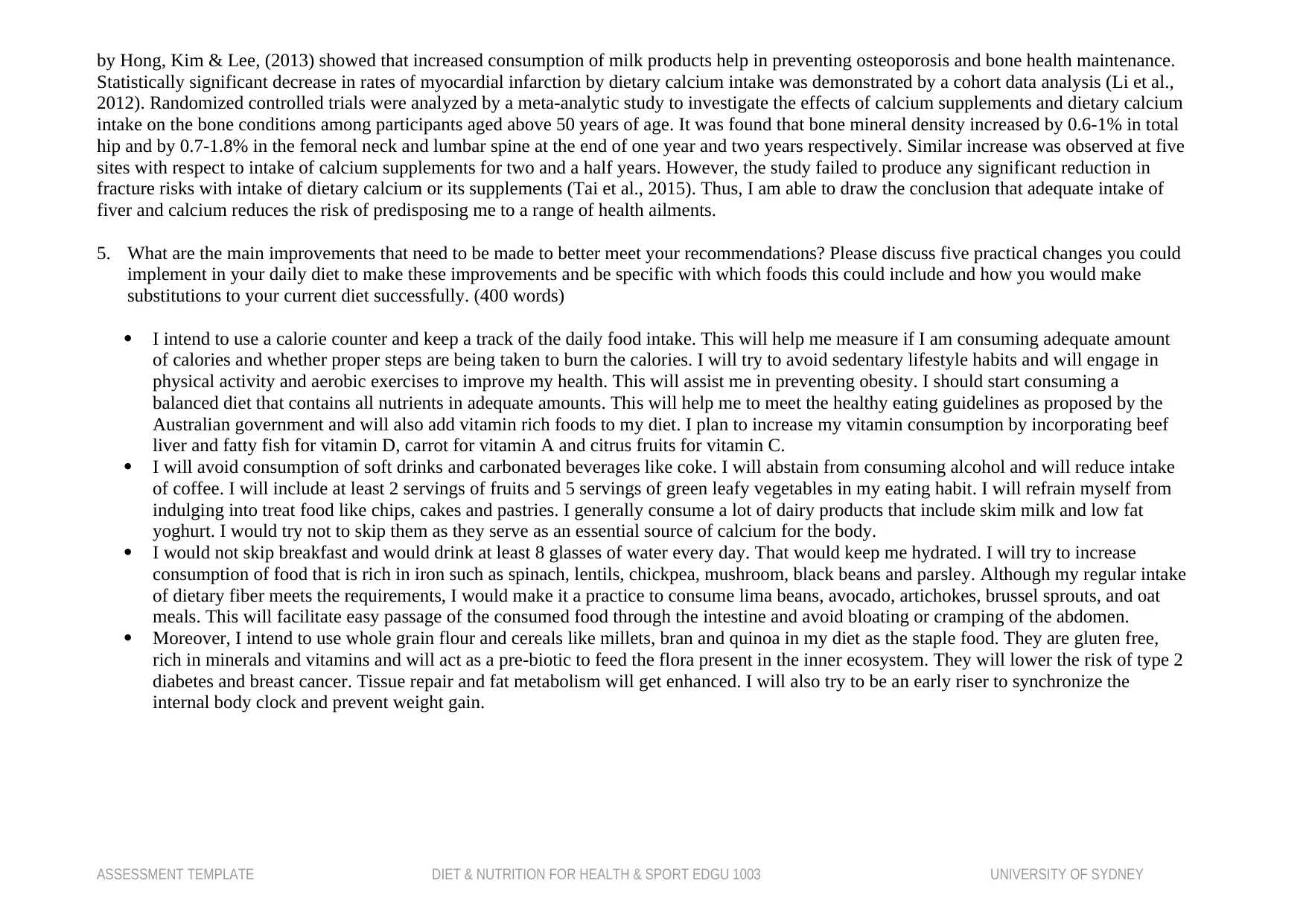
by Hong, Kim & Lee, (2013) showed that increased consumption of milk products help in preventing osteoporosis and bone health maintenance.
Statistically significant decrease in rates of myocardial infarction by dietary calcium intake was demonstrated by a cohort data analysis (Li et al.,
2012). Randomized controlled trials were analyzed by a meta-analytic study to investigate the effects of calcium supplements and dietary calcium
intake on the bone conditions among participants aged above 50 years of age. It was found that bone mineral density increased by 0.6-1% in total
hip and by 0.7-1.8% in the femoral neck and lumbar spine at the end of one year and two years respectively. Similar increase was observed at five
sites with respect to intake of calcium supplements for two and a half years. However, the study failed to produce any significant reduction in
fracture risks with intake of dietary calcium or its supplements (Tai et al., 2015). Thus, I am able to draw the conclusion that adequate intake of
fiver and calcium reduces the risk of predisposing me to a range of health ailments.
5. What are the main improvements that need to be made to better meet your recommendations? Please discuss five practical changes you could
implement in your daily diet to make these improvements and be specific with which foods this could include and how you would make
substitutions to your current diet successfully. (400 words)
I intend to use a calorie counter and keep a track of the daily food intake. This will help me measure if I am consuming adequate amount
of calories and whether proper steps are being taken to burn the calories. I will try to avoid sedentary lifestyle habits and will engage in
physical activity and aerobic exercises to improve my health. This will assist me in preventing obesity. I should start consuming a
balanced diet that contains all nutrients in adequate amounts. This will help me to meet the healthy eating guidelines as proposed by the
Australian government and will also add vitamin rich foods to my diet. I plan to increase my vitamin consumption by incorporating beef
liver and fatty fish for vitamin D, carrot for vitamin A and citrus fruits for vitamin C.
I will avoid consumption of soft drinks and carbonated beverages like coke. I will abstain from consuming alcohol and will reduce intake
of coffee. I will include at least 2 servings of fruits and 5 servings of green leafy vegetables in my eating habit. I will refrain myself from
indulging into treat food like chips, cakes and pastries. I generally consume a lot of dairy products that include skim milk and low fat
yoghurt. I would try not to skip them as they serve as an essential source of calcium for the body.
I would not skip breakfast and would drink at least 8 glasses of water every day. That would keep me hydrated. I will try to increase
consumption of food that is rich in iron such as spinach, lentils, chickpea, mushroom, black beans and parsley. Although my regular intake
of dietary fiber meets the requirements, I would make it a practice to consume lima beans, avocado, artichokes, brussel sprouts, and oat
meals. This will facilitate easy passage of the consumed food through the intestine and avoid bloating or cramping of the abdomen.
Moreover, I intend to use whole grain flour and cereals like millets, bran and quinoa in my diet as the staple food. They are gluten free,
rich in minerals and vitamins and will act as a pre-biotic to feed the flora present in the inner ecosystem. They will lower the risk of type 2
diabetes and breast cancer. Tissue repair and fat metabolism will get enhanced. I will also try to be an early riser to synchronize the
internal body clock and prevent weight gain.
ASSESSMENT TEMPLATE DIET & NUTRITION FOR HEALTH & SPORT EDGU 1003 UNIVERSITY OF SYDNEY
Statistically significant decrease in rates of myocardial infarction by dietary calcium intake was demonstrated by a cohort data analysis (Li et al.,
2012). Randomized controlled trials were analyzed by a meta-analytic study to investigate the effects of calcium supplements and dietary calcium
intake on the bone conditions among participants aged above 50 years of age. It was found that bone mineral density increased by 0.6-1% in total
hip and by 0.7-1.8% in the femoral neck and lumbar spine at the end of one year and two years respectively. Similar increase was observed at five
sites with respect to intake of calcium supplements for two and a half years. However, the study failed to produce any significant reduction in
fracture risks with intake of dietary calcium or its supplements (Tai et al., 2015). Thus, I am able to draw the conclusion that adequate intake of
fiver and calcium reduces the risk of predisposing me to a range of health ailments.
5. What are the main improvements that need to be made to better meet your recommendations? Please discuss five practical changes you could
implement in your daily diet to make these improvements and be specific with which foods this could include and how you would make
substitutions to your current diet successfully. (400 words)
I intend to use a calorie counter and keep a track of the daily food intake. This will help me measure if I am consuming adequate amount
of calories and whether proper steps are being taken to burn the calories. I will try to avoid sedentary lifestyle habits and will engage in
physical activity and aerobic exercises to improve my health. This will assist me in preventing obesity. I should start consuming a
balanced diet that contains all nutrients in adequate amounts. This will help me to meet the healthy eating guidelines as proposed by the
Australian government and will also add vitamin rich foods to my diet. I plan to increase my vitamin consumption by incorporating beef
liver and fatty fish for vitamin D, carrot for vitamin A and citrus fruits for vitamin C.
I will avoid consumption of soft drinks and carbonated beverages like coke. I will abstain from consuming alcohol and will reduce intake
of coffee. I will include at least 2 servings of fruits and 5 servings of green leafy vegetables in my eating habit. I will refrain myself from
indulging into treat food like chips, cakes and pastries. I generally consume a lot of dairy products that include skim milk and low fat
yoghurt. I would try not to skip them as they serve as an essential source of calcium for the body.
I would not skip breakfast and would drink at least 8 glasses of water every day. That would keep me hydrated. I will try to increase
consumption of food that is rich in iron such as spinach, lentils, chickpea, mushroom, black beans and parsley. Although my regular intake
of dietary fiber meets the requirements, I would make it a practice to consume lima beans, avocado, artichokes, brussel sprouts, and oat
meals. This will facilitate easy passage of the consumed food through the intestine and avoid bloating or cramping of the abdomen.
Moreover, I intend to use whole grain flour and cereals like millets, bran and quinoa in my diet as the staple food. They are gluten free,
rich in minerals and vitamins and will act as a pre-biotic to feed the flora present in the inner ecosystem. They will lower the risk of type 2
diabetes and breast cancer. Tissue repair and fat metabolism will get enhanced. I will also try to be an early riser to synchronize the
internal body clock and prevent weight gain.
ASSESSMENT TEMPLATE DIET & NUTRITION FOR HEALTH & SPORT EDGU 1003 UNIVERSITY OF SYDNEY
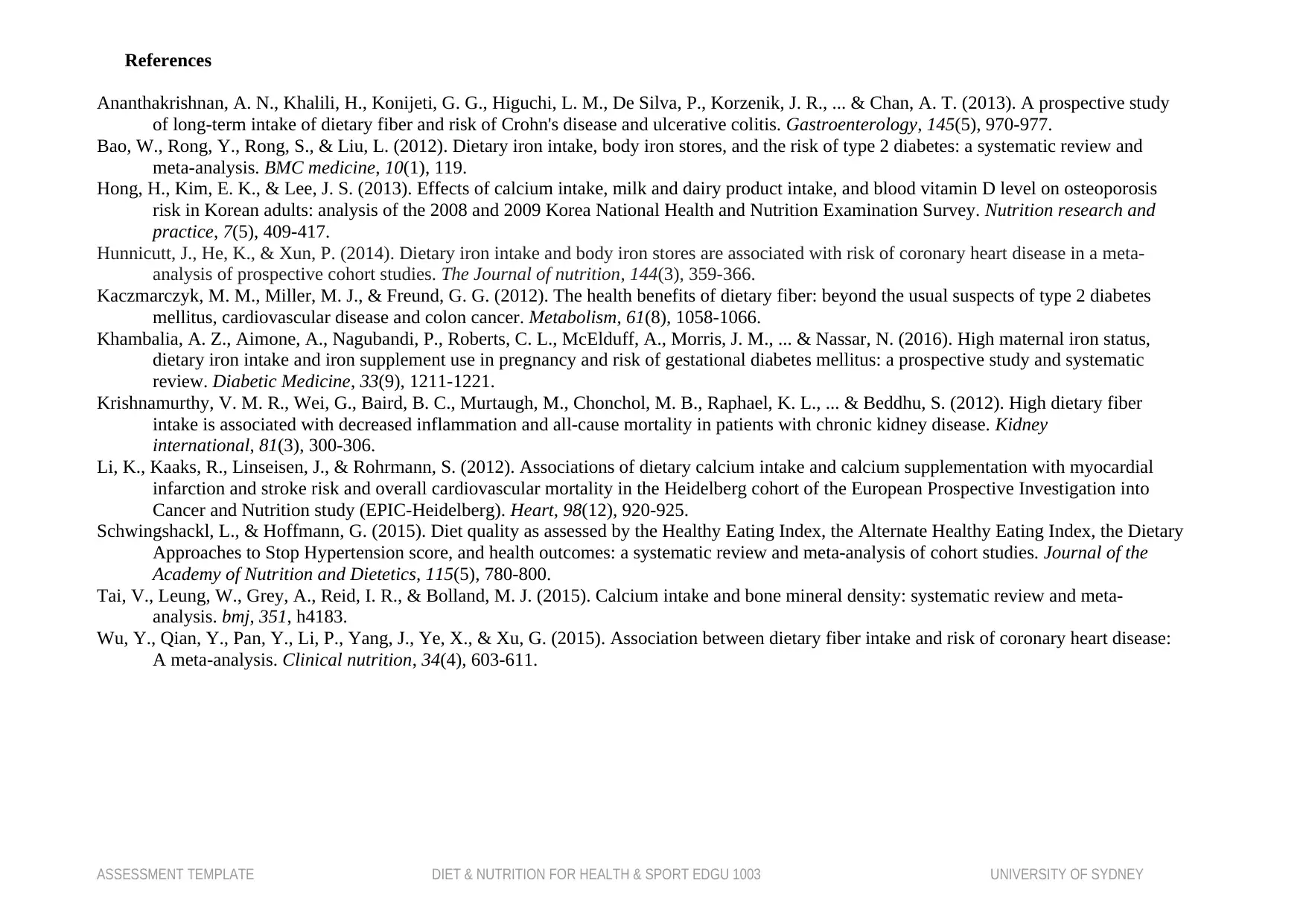
References
Ananthakrishnan, A. N., Khalili, H., Konijeti, G. G., Higuchi, L. M., De Silva, P., Korzenik, J. R., ... & Chan, A. T. (2013). A prospective study
of long-term intake of dietary fiber and risk of Crohn's disease and ulcerative colitis. Gastroenterology, 145(5), 970-977.
Bao, W., Rong, Y., Rong, S., & Liu, L. (2012). Dietary iron intake, body iron stores, and the risk of type 2 diabetes: a systematic review and
meta-analysis. BMC medicine, 10(1), 119.
Hong, H., Kim, E. K., & Lee, J. S. (2013). Effects of calcium intake, milk and dairy product intake, and blood vitamin D level on osteoporosis
risk in Korean adults: analysis of the 2008 and 2009 Korea National Health and Nutrition Examination Survey. Nutrition research and
practice, 7(5), 409-417.
Hunnicutt, J., He, K., & Xun, P. (2014). Dietary iron intake and body iron stores are associated with risk of coronary heart disease in a meta-
analysis of prospective cohort studies. The Journal of nutrition, 144(3), 359-366.
Kaczmarczyk, M. M., Miller, M. J., & Freund, G. G. (2012). The health benefits of dietary fiber: beyond the usual suspects of type 2 diabetes
mellitus, cardiovascular disease and colon cancer. Metabolism, 61(8), 1058-1066.
Khambalia, A. Z., Aimone, A., Nagubandi, P., Roberts, C. L., McElduff, A., Morris, J. M., ... & Nassar, N. (2016). High maternal iron status,
dietary iron intake and iron supplement use in pregnancy and risk of gestational diabetes mellitus: a prospective study and systematic
review. Diabetic Medicine, 33(9), 1211-1221.
Krishnamurthy, V. M. R., Wei, G., Baird, B. C., Murtaugh, M., Chonchol, M. B., Raphael, K. L., ... & Beddhu, S. (2012). High dietary fiber
intake is associated with decreased inflammation and all-cause mortality in patients with chronic kidney disease. Kidney
international, 81(3), 300-306.
Li, K., Kaaks, R., Linseisen, J., & Rohrmann, S. (2012). Associations of dietary calcium intake and calcium supplementation with myocardial
infarction and stroke risk and overall cardiovascular mortality in the Heidelberg cohort of the European Prospective Investigation into
Cancer and Nutrition study (EPIC-Heidelberg). Heart, 98(12), 920-925.
Schwingshackl, L., & Hoffmann, G. (2015). Diet quality as assessed by the Healthy Eating Index, the Alternate Healthy Eating Index, the Dietary
Approaches to Stop Hypertension score, and health outcomes: a systematic review and meta-analysis of cohort studies. Journal of the
Academy of Nutrition and Dietetics, 115(5), 780-800.
Tai, V., Leung, W., Grey, A., Reid, I. R., & Bolland, M. J. (2015). Calcium intake and bone mineral density: systematic review and meta-
analysis. bmj, 351, h4183.
Wu, Y., Qian, Y., Pan, Y., Li, P., Yang, J., Ye, X., & Xu, G. (2015). Association between dietary fiber intake and risk of coronary heart disease:
A meta-analysis. Clinical nutrition, 34(4), 603-611.
ASSESSMENT TEMPLATE DIET & NUTRITION FOR HEALTH & SPORT EDGU 1003 UNIVERSITY OF SYDNEY
Ananthakrishnan, A. N., Khalili, H., Konijeti, G. G., Higuchi, L. M., De Silva, P., Korzenik, J. R., ... & Chan, A. T. (2013). A prospective study
of long-term intake of dietary fiber and risk of Crohn's disease and ulcerative colitis. Gastroenterology, 145(5), 970-977.
Bao, W., Rong, Y., Rong, S., & Liu, L. (2012). Dietary iron intake, body iron stores, and the risk of type 2 diabetes: a systematic review and
meta-analysis. BMC medicine, 10(1), 119.
Hong, H., Kim, E. K., & Lee, J. S. (2013). Effects of calcium intake, milk and dairy product intake, and blood vitamin D level on osteoporosis
risk in Korean adults: analysis of the 2008 and 2009 Korea National Health and Nutrition Examination Survey. Nutrition research and
practice, 7(5), 409-417.
Hunnicutt, J., He, K., & Xun, P. (2014). Dietary iron intake and body iron stores are associated with risk of coronary heart disease in a meta-
analysis of prospective cohort studies. The Journal of nutrition, 144(3), 359-366.
Kaczmarczyk, M. M., Miller, M. J., & Freund, G. G. (2012). The health benefits of dietary fiber: beyond the usual suspects of type 2 diabetes
mellitus, cardiovascular disease and colon cancer. Metabolism, 61(8), 1058-1066.
Khambalia, A. Z., Aimone, A., Nagubandi, P., Roberts, C. L., McElduff, A., Morris, J. M., ... & Nassar, N. (2016). High maternal iron status,
dietary iron intake and iron supplement use in pregnancy and risk of gestational diabetes mellitus: a prospective study and systematic
review. Diabetic Medicine, 33(9), 1211-1221.
Krishnamurthy, V. M. R., Wei, G., Baird, B. C., Murtaugh, M., Chonchol, M. B., Raphael, K. L., ... & Beddhu, S. (2012). High dietary fiber
intake is associated with decreased inflammation and all-cause mortality in patients with chronic kidney disease. Kidney
international, 81(3), 300-306.
Li, K., Kaaks, R., Linseisen, J., & Rohrmann, S. (2012). Associations of dietary calcium intake and calcium supplementation with myocardial
infarction and stroke risk and overall cardiovascular mortality in the Heidelberg cohort of the European Prospective Investigation into
Cancer and Nutrition study (EPIC-Heidelberg). Heart, 98(12), 920-925.
Schwingshackl, L., & Hoffmann, G. (2015). Diet quality as assessed by the Healthy Eating Index, the Alternate Healthy Eating Index, the Dietary
Approaches to Stop Hypertension score, and health outcomes: a systematic review and meta-analysis of cohort studies. Journal of the
Academy of Nutrition and Dietetics, 115(5), 780-800.
Tai, V., Leung, W., Grey, A., Reid, I. R., & Bolland, M. J. (2015). Calcium intake and bone mineral density: systematic review and meta-
analysis. bmj, 351, h4183.
Wu, Y., Qian, Y., Pan, Y., Li, P., Yang, J., Ye, X., & Xu, G. (2015). Association between dietary fiber intake and risk of coronary heart disease:
A meta-analysis. Clinical nutrition, 34(4), 603-611.
ASSESSMENT TEMPLATE DIET & NUTRITION FOR HEALTH & SPORT EDGU 1003 UNIVERSITY OF SYDNEY
1 out of 10
Related Documents
Your All-in-One AI-Powered Toolkit for Academic Success.
+13062052269
info@desklib.com
Available 24*7 on WhatsApp / Email
![[object Object]](/_next/static/media/star-bottom.7253800d.svg)
Unlock your academic potential
© 2024 | Zucol Services PVT LTD | All rights reserved.




